
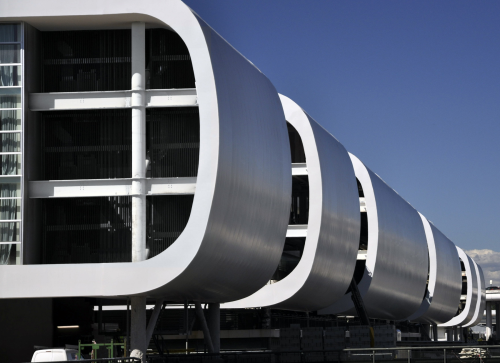
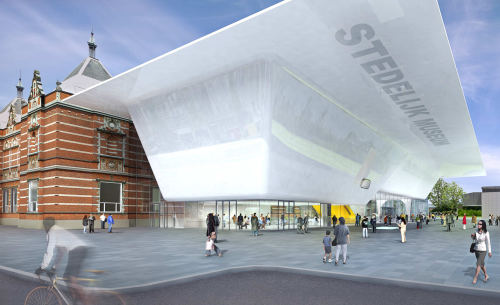
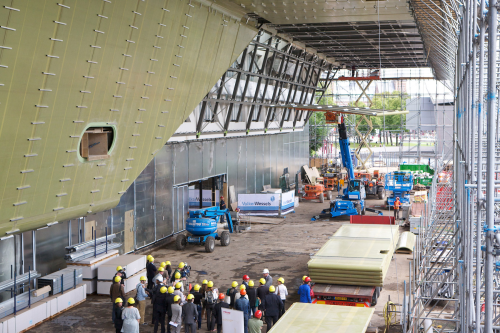
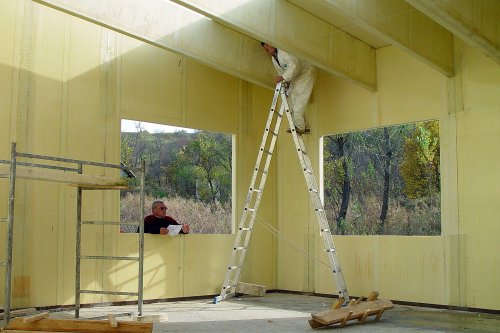
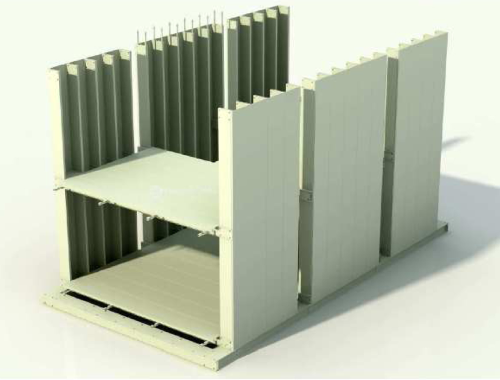
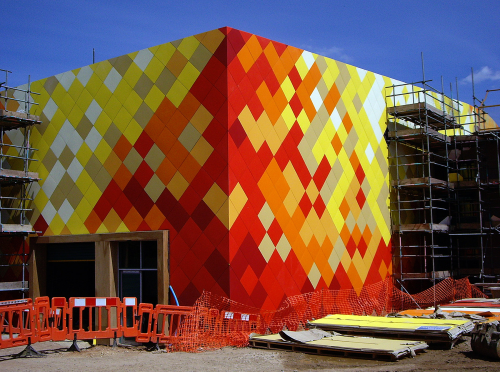
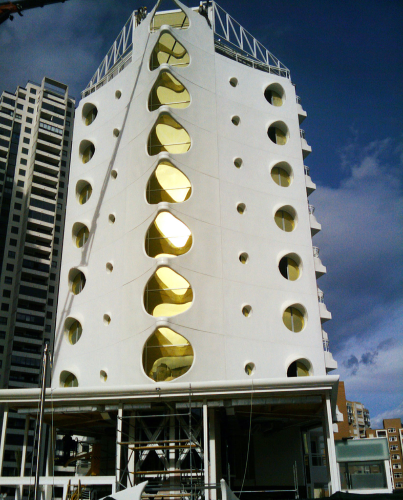
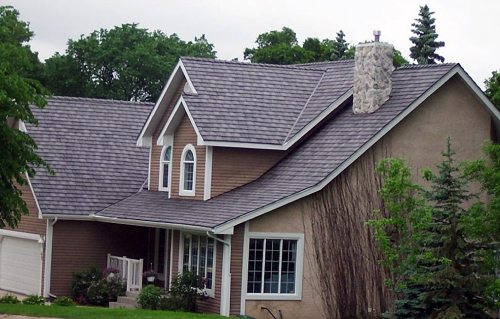
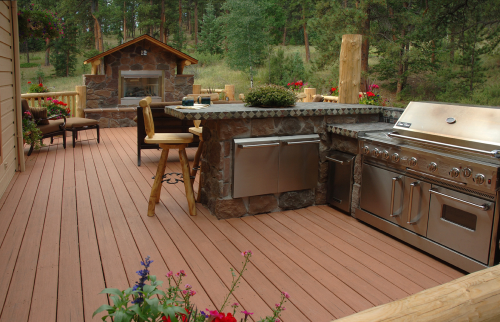
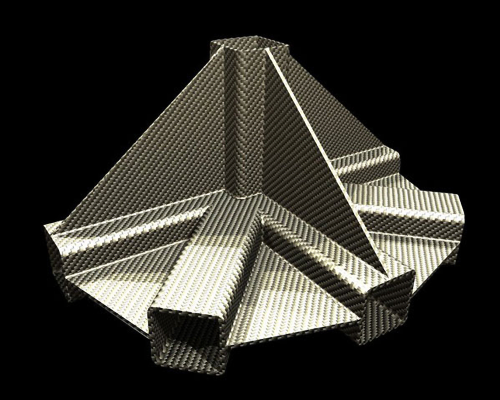
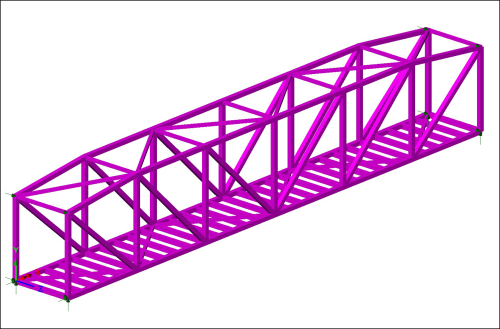
Construction is one of largest consumers of fibre reinforced plastic (FRP) composites both in Europe and North America. A dozen major applications of composites are used in the building and construction industry, including panels, beams, columns, doors, windows, decking, architectural applications and reinforcing bars. The slowdown in residential construction has caused a decline, but researchers at Lucintel predict that construction applications for composites in North America will reach US$6.1 billion by 2013. Continued growth can be expected in Europe, as well.
An interactive website called CompositeBuild.com showcases and promotes composites in building and construction. Sponsored by Ashland Performance Materials, a global supplier of unsaturated polyester resins and epoxy vinyl ester resins, the site enables architects, designers, builders and others who specify building materials to learn about the benefits of composites and connect with manufacturers and distributors.
Innovative modular housing
One manufacturer listed at CompositeBuild.com is Wisconsin, USA-based Ambiente Housing, which has developed a housing system described as an eco-friendly method for building durable modular homes. It is based on composite sandwich panels cored with recycled glass that is crushed to produce Ambi-Cell beads. The beads, containing encapsulated air, are mixed with resin in a patented process to produce the core material, Ambi-Core. An Ambiente House can be built in less than a week, the company reports.
Composite Building Structures Ltd of Ft. Meyers, Florida, USA, produces pultruded FRP structural support framing for the walls, roof and floor of buildings. Framed sections up to 60 ft (18.3 m) are assembled using pultruded structural profiles at the factory, then erected at the building site. The sections can be delivered as a skeleton frame or with various combinations of insulation, windows, doors and other pre-installed components and channels. Nearly half of the company’s production is exported to the Caribbean and Latin American countries.
The Startlink Lightweight Building System for low-cost housing and other structural applications is being developed through a £1.3 million (US$ 2.13 million) project funded by the UK government’s Technology Strategy Board, industrial partners, including Exel Composites, OCS Structural Plastics, and several others. A family of lightweight pultruded FRP profiles have been developed along with innovative labour-saving techniques by the consortium, which includes researchers from the University of Warwick.
|
CompositeBuild.com, a website sponsored by Ashland Performance Materials, was conceived as a response to the movement toward green technology and the rapidly emerging green building materials market driven by sustainable building initiatives such as LEED. Bob Moffitt, Ashland Senior Product Manager, speaking at an American Composites Manufacturers Association conference in May, observed that green initiatives are driving changes to materials and processes used in construction. Moffitt discussed the LEED requirement for using recycled materials in structures, including recycled reinforcements and resins derived from recycled content. Ashland offers Envirez™ resin, billed as the world’s first commercially available unsaturated polyester binder resin made using significant quantities of rapidly renewable materials. “We feel that sustainable building programmes lead to broader use of composites in building and construction because they push designers and builders to look for better ways of doing things,” says Moffitt. “This drive for better answers leads to investigation of alternative materials and processes and gives the composite industry an opportunity to show the applications where we have the best material solution.” CompositeBuild.com has gotten very good response from composite fabricators, reports Moffitt. “Our industry is beginning to recognise the value of LEED and other green building initiatives and how these programmes can provide opportunities to talk to architects, designers and other end-users about the benefits of composites.” The website is divided into Residential and Commercial building sections and lists 70 different manufacturers serving the building and construction market. The site has been expanded to include a growing network of European-based composites manufacturers.. Manufacturers and their distributors in North and South America and Europe can be listed on the website free of charge. |
Designed for buildability and adaptability, the Startlink system is designed to eliminate site waste and requires no skilled labour, concrete or wet trades, according to the developers. The fire-resistant, calcium silicate-based profiles in the Startlink system are thin (some are core-filled) to reduce material cost. Snap-fit assembly and hollow-dowelled joints have been engineered to facilitate assembly, without metal fasteners, and minimise labour. Water-saving measures and flood resistance will be integrated into the building design.
According to the Startlink consortium partners, the inherent dimensional stability of pultruded profiles means that airtightness can be achieved easily. Passivhaus and Sustainability Code 6 standards for eco-performance are expected to be met without difficulty and with minimal cost penalty. Construction of the first Startlink house was expected in September.
Homes from packaging
Deutsche Composite GmbH, based in Elbe, Germany, has developed a lightweight building system using its patented RexWall™ FRP composite sandwich panels, which are produced using recycled foam clamshell packaging, coffee cups and other packing material, prompting the slogan: “The sustainable solution to packaging pollution.” The panels are joined using RexWall bonding material, a two-part adhesive which cures in less than two hours.
RexWall structures range from low-cost housing to luxury homes and commercial buildings. The elements are provided in kit form, with all parts numbered. The kits include an assembly manual with detailed instructions. Construction time is very short and cost effective, with virtually no waste, notes the company. RexWall FRP materials are also used to construct floating structures. Since 2003, about 30 floating homes have been built. Even the pontoons are built of RexWall panels.
Innovative Composites International (ICI) of Toronto, Canada, markets affordable EcoScape™ houses, quickly assembled from its Structure-Lite™ composite sandwich panels. The panels feature skins produced from a patented mixture of fibreglass and recycled plastics with a foam core. Aluminium framing supports the panels.
An EcoScape house, said to be ideal for tropical conditions, can be set up in as little as two days, the company says. ICI recently reported that it had signed a US$68 million contract to supply materials for large-scale housing projects in Haiti and Ghana. The company also produces foldable, composite mobile storage containers.
Another fast-build, sandwich-panel approach is the Wall System, developed by Brazilian engineering plastics company MVC Componentes Plasticos LTDA. FRP skins are cored with expanded polystyrene and polyurethane. The panels, which are manufactured in a continuous lamination process that incorporates low-pressure presses, form the walls and ceiling components of the Wall building system.
The interior covering surface of the passenger terminal at the Carrasco International Airport in Montevideo, Uruguay, was finished with gel-coated Wall System panels. The project won several awards for excellence in composites. The panels used in the 24 000 m2 project, which took six months to complete, were lauded for their light weight, strength and paintless finish. They met all mechanical, thermal and acoustic insulation requirements, relates MVC.
Major projects flourishing
According to the International Institute for FRP in Construction (IIFC), the structural engineering community is about to enter a stage in which structural design with FRP composites is poised to become as routine as design with conventional materials in construction and civil engineering projects. An engineering design pre-standard for pultruded FRP structural components, now in the final steps of the American Society of Civil Engineers (ASCE) approval process, is expected to contribute greatly to that expansion.
The 2011 JEC Composites Innovation Award for Construction was presented to Belgium-based 3B, the Fiberglass Company, for the ventilated façade of the Sheraton Hotel at the Milan Malpensa Airport. The façade features an outer skin made of pultruded sheets with a quartz finish. The sheets were produced in 22 m (72.2 ft) long, 1.4 m (4.6 ft) wide strips to facilitate handling at the construction site. The joints in the innovative cladding solution are barely perceptible, material supplier 3B notes.
Composites are changing the face of the Stedelijk Museum in Amsterdam, thanks to the generosity of Japanese fibre manufacturer Teijin, which produced and donated the Twaron aramid and Tenax carbon fibre reinforcements for the FRP panels used in the façade. The manufacturer also reportedly made a substantial financial contribution to the renovation project, which is turning the exterior into a gleaming white façade that seems to float over the 3000 m2 (32 272 ft2) surface. The 271 panels are bonded together, giving the appearance of a seamless façade.
The sandwich panels, reinforced with a unidirectional fabric made from the donated fibres, were produced by Holland Composites using vinyl ester resin and a PIR foam core. The aramid and carbon fibres are said to counteract the expansion of the resin by contracting as the ambient temperature rises. As a result, the composite experiences thermal expansion of only 1 mm per °C of temperature rise, according to Teijin. The same façade of glass fibre FRP or aluminium would expand almost two and half times as much, the fibre manufacturer adds.
In Benidorm, Spain, the exterior of the Vistas Hotel has been refurbished and given a contemporary look with a new façade made up of nine white gel-coated, moulded FRP triangular and elliptical sections produced by Spanish fabricator Miraplas SL. Each section is made of eight moulded parts, produced using three layers of glass matting and isophthalic resin and gel-coat. Light RTM closed moulding and hand lay-up processes were used in the production. Crystic Crestomer structural adhesives manufactured by Scott Bader were used in the assembly of the new façade.
Architectural applications
Architectural Fiberglass Inc (ACI), a Cleveland, Ohio, USA, company specialising in custom designed decorative FRP ornamentation for restoration, reproduction and new construction, uses Ashland’s Hetron™ and Modar™ fire retardant resins in the production of its products. The company is said to be the first fabricator to undergo the rigorous fire testing and quality control inspections required under Section 2612 of the 2009 International Building Code.
Ashland worked with the American Composites Manufacturers Association (ACMA) and the Southwest Research Institute to develop a listing and labelling programme to establish code compliance for products made with Ashland’s fire retardant resins. The Section significantly expanded the use of fire retardant FRP composites in architectural applications.
ACI is known for its large-size fabrications. For one major project, the company produced a decorative FRP parapet wall replicating terra cotta that measures 200 ft (61 m) wide by 20 ft (6.1 m) tall. Another large project was a 41 ft (12.5 m) diameter dome made of FRP composites. Excellent physical properties and moulding capabilities make composite materials well suited for interior and exterior architectural ornamentation, says ACI, noting that its FRP parts typically measure about 3/16 inch (5 mm) thick and feature an exterior gel-coat.
FRP cornice mouldings do not require heavy steel supports or structural rehabilitation of the attachment areas on a building, relates ACI. They can be produced to replicate most finishes, including terra cotta, cast stone, marble, granite, copper, steel and wood. FRP cornice work is very practical when compared with the material, maintenance and installation cost of other traditional materials, notes the company.
|
A new engineering design standard is in the works that promises to be a game changer for pultruded FRP structural components in building and construction. Sponsored by the American Composites Manufacturers Association (ACMA), which funded the project to draft the pre-standard – to the tune of US$1.4 million – and the American Society of Civil Engineers (ASCE), which has handled development, the standard is expected to be published in about a year. Lawrence Bank, professor of civil engineering and associate provost for research at City College of New York, and his colleagues have made presentations at several professional conferences recently to spread the word about the Pre-Standard for Load & Resistance Factor Design (LRFD) of Pultruded Fiber Reinforced Polymer (FRP) Systems and how it will enable architects and structural engineers to incorporate pultruded FRP materials into the design and building process without worrying about liability. The development of a pultrusion design standard had been under discussion for at least 15 years, but not until the ACMA provided the funding three years ago did the project get off the ground, relates Bank, who is president of the International Institute for FRP Composites in Construction. “In school, engineers learn how to design structures in steel, concrete, wood and other conventional materials simply by following a consensus-based standard that has been approved by a code-writing organisation and is included in the statutes of the legal authority or building authority,” he relates. “Until you have a legally accepted code that is developed by a consensus process, liability will rest on the individual designing the structure. That is how liability is transferred in the structural engineering industry in general. Without a code, you will not get widespread use of pultruded materials.” The pre-standard has been drafted in such a way that would allow pultrusion companies to innovate and produce pultrusions with higher performing properties to differentiate themselves from everybody else. “They will be able to report the design allowables according to an ASTM protocol, which defines how to calculate the characteristic values,” explains Bank. “I would hope in the long run that we get to a point where we will have a standard to be able to design any kind of structure out of FRP composites. I think this is just the very beginning of a process that allows the civil engineer or structural designer to start to use composite materials in a routine way.” |
Square FRP panels in a rainbow of seven colours make up the rainscreen cladding of a school project in York, in the UK. Steni UK Ltd, a specialist in fabricating decorative composite interior and exterior façade panels, cut the panels to the precise size needed to cover for the 700 m2 (7 535 ft2) surface area. The panels are of sandwich construction, made of glass reinforced polyester skins and foam core. Electron-cured acrylic coating provides the colour. Steni offers these decorative panels in 44 standard colours and three levels of surface gloss.
Bio-based FRP materials
RTP Company, based in Minnesota, USA, recently commercialised the first glass fibre reinforced polylactic acid (PLA) compound, claiming improved strength, stiffness and thermal performance for durable and semi-durable applications. RTP, a custom compounder of engineered resins, reports that the compound provides higher tensile strength, flexural modulus and heat deflection temperature than 30% glass-filled polypropylene (PP).The company’s engineered bioplastic compounds provides additional material options for sustainable building initiatives such as LEED, relates RTP, claiming that the new compound “just begins to scratch the surface” of what can be done in compounding PLA. The company’s Eco Solutions line also includes compounds with bio-based and recycled resins, natural fibres and halogen-free flame retardant additives.
A bio-based composite material developed specifically for window frames by French research and development company Innobat caught the eye of 2011 JEC Innovation Awards judges, who named the product the winner in the Bio-based Materials category. A bio-based epoxy resin reinforced with 65% flax fibres was used to pultrude the profiles used in the window frames, which are said to provide the properties needed to compete with PVC and aluminium in this application.
Up on the roof, Enviroshake Composite Engineered Roofing of Ontario, Canada, produces composite roof shingles that impart the look of a “silvered” taper-split cedar roof plus offer better durability and maintenance-free benefits, says the manufacturer. The product is made from 95% recycled and reclaimed materials, including post-industrial plastics, crumb rubber from tyres and cellulosic fibres. The shingles are backed by a 50-year warranty.
Natures Composites in Wyoming, USA, produces TerraFence™ composite fencing products and TerraDeck™ composite decking products from recycled high density polyethylene (HDPE) reinforced with wheat straw cellulose fibres. With a cellulose structure similar yet superior to wood, wheat straw provides a strong, stable fibre ideal for achieving maximum density and consistent performance, says the company. Wheat straw, a byproduct of the agriculture industry, is pulverised and mixed with melted post-consumer HDPE plastic that is processed and extruded into a variety of lumber material, shapes and sizes.
Another alternative to wood is produced by LifeTime Lumber, based in Wisconsin, USA. Polyurethane resin is combined in a patented process with mineral ash, a byproduct of coal fire powered electricity generation plants, to produce the composite material, which is extruded into profiles. The company claims the product to be highly durable, noting that it does not crack or split and experiences minimal expansion, contraction or water absorption.
WPC decking products
Composite decking products are expected to account for nearly 70% of US demand growth through 2014, according to a market study by Freedonia. Advantages over wood decking include low maintenance, the perception of consumers that it is environmentally friendly and the introduction of hidden fastener systems that make installation easier, reports Freedonia. Decking is the largest consumer of wood-plastic composites (WPC), and many manufacturers compete in this growing market.
An innovative decking manufacturer is Advanced Environmental Recycling Technologies (AERT) of Arkansas, USA, which uses cedar wood fibres and 95% recycled polyethylene content in one of its lines to produce profiles that have the look and feel of real wood, the company relates. Another line, the MoistureShield® Vantage ProSeries Collection, features TecShield technology for a smoother, more durable surface designed to resist dirt. The decking can be installed on the ground or in contact with water without voiding the limited lifetime warranty, notes AERT. The decking is available in eight fade-resistant colours and is reversible.
|
A multi-sector project in the UK to develop woven carbon fibre joining nodes for a new generation of lightweight structures is in its final stages and offers great promise. The Advanced Composite Truss System (ACTS) project has focused on composite space frame technology, specifically node manufacturing and joining. The goal is to produce all-composite truss structures and space frames made of resin-infused, 3D woven and 2D aligned reinforcements. The project represents an investment of £1.8 million (US$ 2.94 million), which was funded by the Technology Strategy Board and a consortium of industry partners. The development of a 3D woven carbon fibre nodal structure, upon which the joining system is based, earned the 2011 JEC Innovation Award in the Process category for weaver Sigmatex UK Ltd and the consortium. Neil Farmer, Executive Director, Tony Gee & Partners LLP, a Surrey, UK-based consultancy of civil, structural and geotechnical engineers, was scheduled to give a keynote talk on the system at the Advanced Composites in Construction 2011 Conference at the University of Warwick in September. The firm, which is one of the project partners, is focusing on applications in the civil engineering sector. “The 3D woven element is the reason we got government funding, because it really is a world-leading technology,” observes Farmer. He relates that Sigmatex developed the weaving technology that can produce 3D shapes by weaving in two dimensions. “The nodes enable various other members to be joined together in a truss structure, he explains. “This project has been about producing a generic node that has all sorts of variation which can address a multitude of challenges in design, manufacturing, materials and production,” says Farmer. “Among many different types of applications, we expect them to be used to produce wholly composite footbridges for civil infrastructure.” The longest composite footbridge in the UK has a span of about 26 m (85 ft), and Farmer believes a truss bridge built with the new technology will be able to reach across longer spans and weigh 25% less than earlier composite bridges. By producing the generic nodes and composite elements in volume, the cost of production will drop. He anticipates that by building 20 bridges at a time instead of just one, a 64% reduction in cost can be realised. |
Nyloboard, a Georgia, USA, manufacturer of composites, uses an exclusive, patented manufacturing technology that utilises 100% recycled, post-consumer carpet fibres and VOC-bonding resin to produce NyloDeck® decking products. Surfaces are embossed to provide the look of wood grain. Impervious to water, NyloDeck does not absorb moisture, does not swell or delaminate, and is not susceptible to mold and mildew, the company reports.
A new technology that produces WPC pellets for use in extrusion and injection moulding has been developed by Crown Research Institute Scion in New Zealand, which has filed international patents for the technology. It enables production of wood-plastic composites with long fibre reinforcements that can be used in existing manufacturing and processing lines, relates Scion. A licensing agreement has been signed with Sonae Industrial Group to commercialise the technology in Europe. ♦
This article was published in the September/October 2011 issue of Reinforced Plastics magazine.To apply to receive your free copy of each issue of Reinforced Plastics magazine please complete the subscription form.





